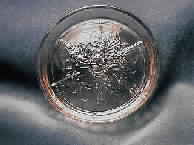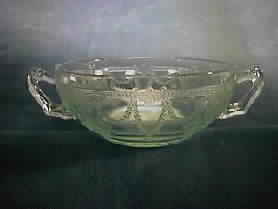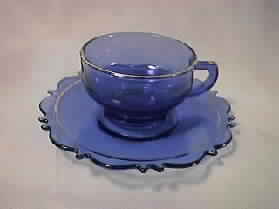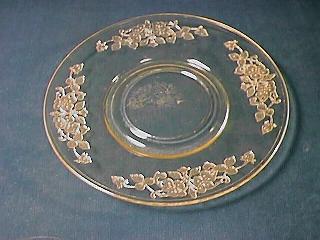|
|
|
|
|
|
|
|
|
|
|
|
|
|
|
|
|
|
|
|
 |
 |
 |
 |
 |
 |
 |
 |
 |
 |
 |
 |
 |
 |
|
|
|
 |
 |
 |
| Introduction to Depression Glass |
| by Rosemary Trietsch |
 |
|
|
|
 |
|
|
|
 |
 |
 |
| For those of you who are new to Depression glass, welcome to the first of what I hope will be an educational and fun series of articles covering Depression glass patterns from the 'A to Z' list. For those of you who have been reading my column on Depression glass for the past two and a half years, it will now be found here. |
 |
|
|
 |
 |
 |
|
|
|
 |
 |
 |
| Back in January, I received a call from the folks at "Treasures in Your Home." It seems they were thinking about doing a segment focusing on glass and had some questions. (As Just Glass is a partner on the Collecting Channel and Collecting Channel owns "Treasures," I was the logical person to call.) The producer asked me to come on the show and talk about different types of collectible glassware. They wanted me to discuss Carnival Glass, Depression glass, Elegant Glass, American Brilliant Cut, and Early American Pattern Glass. Oh, and they would give me 4 minutes to do it - one whole minute longer than the regular spot. My response was 5 minutes of hysterical laughter. |
| When I finally caught my breath and apologized, I explained to the |
| producer that 4 minutes would barely be enough time to show an example of each type of glass, let alone explain what it is, and suggested that they focus on just one area. "Well," she said, "I've always wondered what Depression glass is. I heard they gave it out in movies or something like that, but that's about all I know." Now, I've been buying, selling and collecting Depression glass for over 12 years, so this is a question I've heard a few times before, and I was happy to supply her with an introduction to this distinctly American collectible. |
 |
|
|
 |
 |
 |
 |
 |
 |
 |
 |
 |
|
 |
 |
|
|
|
 |
 |
 |
| In a nutshell, Depression glass is machine produced glass made in America from the mid 1920's through the 1930's. It was inexpensive, and came in a variety of colors: pink, red, green, amber, yellow, blue, cobalt, white and crystal. This glass was given out at the movies, in flour bags or soapboxes. Some pieces were premiums for sending in coupons, trading stamps and proofs-of-purchase, while others could only be purchased (Heaven forbid!) at stores like Woolworth's. Now, the definition you just read is pretty straightforward and self-explanatory, and the producer was happy with it. But then she said, "So why do people collect it?" and it made me stop and think. Why do people collect it? What is it about this stuff that causes otherwise sane individuals to jump from moving vehicle and run half a block to get to a table of kitchen shakers and canisters. (Yes, I did and yes, I bought everything on the table. But that's another story.) So let's go back to the beginning and look at Depression glass a little more closely. |
 |
|
|
 |
 |
 |
 |
 |
 |
 |
 |
 |
 |
|
 |
 |
|
|
|
 |
 |
 |
| In the early 1900's, glass making was a traditional art form, using |
| techniques passed from generation to generation. In factories, glass items were poured, pressed, cut and polished by hand. Iridescence was sprayed on each piece individually, and formulas for color were known only to a select few. It was the individual artisans that made a company what it was. The master craftsman taught his apprentice the secrets that would turn each plate into something special. But, because of the handwork involved, this glass was too expensive for the majority to own. Only the privileged could afford full table settings of this wonderful stuff, and so it became a prestigious thing to own even a single piece. |
| The majority of the glass produced before 1920 was crystal, but, by the mid 1920's, color was the rage. Companies like Cambridge, Heisey, and Duncan & Miller were producing table glassware in the beautiful colors we're so familiar with today. The allure that colored glass held for the common folk was not lost on the marketing and advertising people of the time. They recognized the fact that if you could produce it cheaply enough and in great quantities, you could make a fortune. Factories moved toward automated production, and by 1924, trade papers already describe Jeannette Glass Company as "one of the most complete automatic factories in the country."(HMW2). |
 |
|
|
 |
 |
 |
 |
 |
 |
 |
 |
|
 |
 |
 |
 |
 |
|
|
|
 |
 |
 |
| By 1928, full lines of table settings were being machine produced and sold at prices everyone could afford. These fully machine made patterns are what we refer to as the 'A to Z' Depression glass patterns. They were produced in great numbers to keep up with the demands of the public who wanted to set their tables in the same lovely rainbow of colors that the Vanderbilt's might use. Different patterns were introduced, many of which - like Cameo, Sandwich, and Miss America- were copies of patterns produced by the more expensive, hand made glass factories. The glass may have been of lesser quality, but it sure was pretty on the table. |
| Of course, 1929 brought on the Great Depression. Money formerly spent on plates and bowls was needed to buy necessities like food and clothing. Movies and carnivals were frivolousuntil those clever marketing people realized the attraction of a piece of colored glass. Suddenly, that nickel bought an afternoon of enjoyment AND another plate to add to your setting. At the carnival, if you tossed that penny just right, why, you could come home with an entire lemonade set. But what was it about a pink pitcher and tumblers that could make people spend what little money they had on a movie or a carnival or a bag of cake flour when there was so much more they needed? Perhaps that tumbler evoked the memory of a more prosperous time - the 1920's- when things were better. Perhaps, in the middle of a terrible ordeal. |
 |
|
|
 |
 |
 |
|
|
|
 |
 |
 |
| "they glimpsed an old, sweet dream shining in the darkness just ahead of themFor many, many families it became something they could focus on, group around, work towards, in its own small way. For some, simply owning a piece of it was enough; it afforded a bit of brightness they would never forget."(HMW2) |
| Today, there are as many reasons for collecting Depression glass as there are collectors. Some are drawn to color, others to shape or design. But one thing that strikes me whenever I'm around a group of collectors is the number of people who started collecting because of a single plate or bowl that they remember from childhood. Whether it was 'Grandma's fruit bowl' or 'the little glasses I drank from as a kid', there's usually a motivation beyond the piece of glass itself that causes us to dash across four lane highways to get to that treasure sitting among the Corelle at a garage sale. |
 |
|
|
 |
 |
 |
 |
|
|
|
 |
 |
 |
| What was a symbol of better times for our parents and grandparents, is for us a piece of our past that we can hold on to. It came from a time in our history when hardship was the way of life. Every piece that exists today is here because someone stretched the flour just a little farther so there would be a few extra pennies left over to spend on a plate. Hopefully, we can pass this feeling on to our children. Use your glass. Make it a part of daily life so that your kids will remember 'those little glasses with the daisies on them' or 'the marigold pitcher Mom always used at Thanksgiving'. It's a little bit of history we can preserve. |
| Next month, we'll begin exploring the A to Z patterns. If you've got a favorite, by all means let me know. Your comments and contributions are always welcome. |
|
| Thanks for stopping by, |
| Rosemary |
| |
|
| *Quoted from HMW2 = Colored Glassware of the Depression Era, Book 2 by Hazel Marie Weatherman, copyright 1974. |
 |
|
|
 |
 |
 |
 |
 |
 |
 |
 |
 |
 |
|
|



